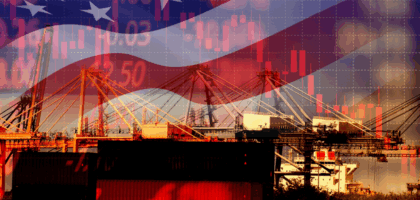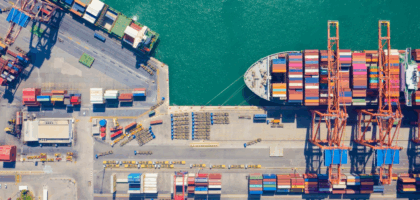It seems like forever since COVID changed life as we know it. The unexpected virus created a global pandemic in a way the world hadn’t seen since the Swine Flu in 2009. With 2022 being a bumpy year and a new year approaching, will things begin to look more normal for the global supply chain?
The Current State of Shipping
Let’s face it: 2022 was literally a year of recovery from the supply chain disruptions the world began facing in 2020. The COVID-19 pandemic wreaked havoc on global supply chains and created everything from worker shortages to complete country lockdowns to never-before-seen port congestion.
Throughout this year, all these issues were felt by both retailers and consumers with 97% of the National Retail Federation (NRF) members reporting that port congestion and shipping delays drastically affected their operations and 60% of consumers saying they were unable to get product due to shortages and delays.
Not only that, but the global logistics industry was greatly affected by several incidents including the Great Resignation, the overwhelming increase in oil and diesel prices, and the ongoing U.S. rail and port crises, which put shipping companies and ports at a great disadvantage.
What can we expect to see in 2023?
Next year will by no means be the “normal” we were used to pre-pandemic. There will be some positive changes but much of the industry will continue to face challenges.
1. Container shipping costs and backlogs will decrease, but congestion and delays won’t completely end.
Slowing consumer demand brought some relief to global supply chains in 2022, and although major ports (including LA-Long Beach and Shanghai) managed to make it through unprecedented backlogs, there is still a long way to go before global congestion eases.
According to the Freightos Baltic Index, a global container index, the current global average cost of shipping a container is $3,429, compared to $10,396 in October 2021. This is due to the increase in shipping capacity which is helping to lower costs. However, rates are unlikely to return to pre-pandemic levels as long as fuel costs remain inflated by the Russia-Ukraine war.
Since May, global schedule reliability, tracked by Sea Intelligence, has embarked on a cautious recovery path, standing at 46.2% in August. However, this is still a long way from the 2018-2019 average of 74%. In addition, some 7% of cargo ships are stuck queuing up in ports around the world, with 11% of goods still being prevented from making it to their final destination in a timely manner.
2. Labor shortages will (unfortunately) continue.
This year has seen its fair share of strikes and labor negotiations in the transportation sector due to spiking inflation and eroding purchasing power. Between the always-surprising union strikes at the rails and ports—not to mention, the lack of workers the trucking industry has been facing for years now—labor shortages will continue to be at the forefront of concerns for the foreseeable future. Couple that with the ongoing pandemic and continuous global conflicts, and you have the perfect recipe for a strained workforce.
3. Growth in world trade will stay slightly behind world GDP.
With fears of a recession running high right now, global trade experts don’t expect world trade to exceed 2% next year and have “penciled” in a subdued growth rate of just 1.2% for global goods trade. This falls short of the expected GDP growth.
There are a few factors contributing to the conservative growth expectations, including 1) a weakening consumer demand, 2) the subsequent inflation crisis persisting, and 3) ongoing labor and material shortages. In addition, energy prices are very likely to remain high, which will ultimately burden the cost competitiveness of businesses and consumer buying power.
4. Supply chains will remain fragile.
Despite the progress the industry has made this year on port congestion and reducing shipping costs, global supply chains remain “fragile.” The increasing amount of cargo ships now being seen at East Coast U.S. ports and the shortage of containers are contributing to longer lead times and shipment delays.
In addition, the lack of precise ETAs (estimated time of arrival) and unreliable transportation schedules from various carriers has resulted in a lack of visibility across the supply chain. Many companies have been operating in the dark and have had difficulty providing adequate updates to their customers.
5. Sustainability will grow in importance.
Sustainability has been an increasingly important topic to both companies and consumers over the past few years. Consumers are concerned by the impact of their purchasing habits and how their choices impact the environment, which has resulted in them purchasing more recycled and refurbished goods.
In 2023, evolving consumer demands and stricter government regulations will continue pushing businesses to adopt greener initiatives and practices from sourcing sustainable raw materials to evaluating greenhouse gas emissions from their transportation providers.
Looking Ahead to the Future
ICAT Logistics always looks ahead to the future and plans for different events that may occur and impact the global supply chain. With these expectations above, our team will continue to work diligently, monitor each situation, and inform our customers of anything that may impact their business and supply chain operations.
Interested in learning more about changes, trends, and events that could impact your bottom line? Be sure to sign up for our weekly Bottom Line newsletter!
Resources:
- Shipping Trends 2023: Key Trends for Retailers to Watch This Year (Shopify)
- Trade Outlook 2023: Slow Steaming in Rough Waters (ING Think)
- 2023 Supply Chain Trends: What You Should Know (Flat World Global Solutions)
- Freight Shipping Trends in 2023 (Freight Club)
- 4 Supply Chain Challenges That Will Continue in 2023 (Cargobase)



